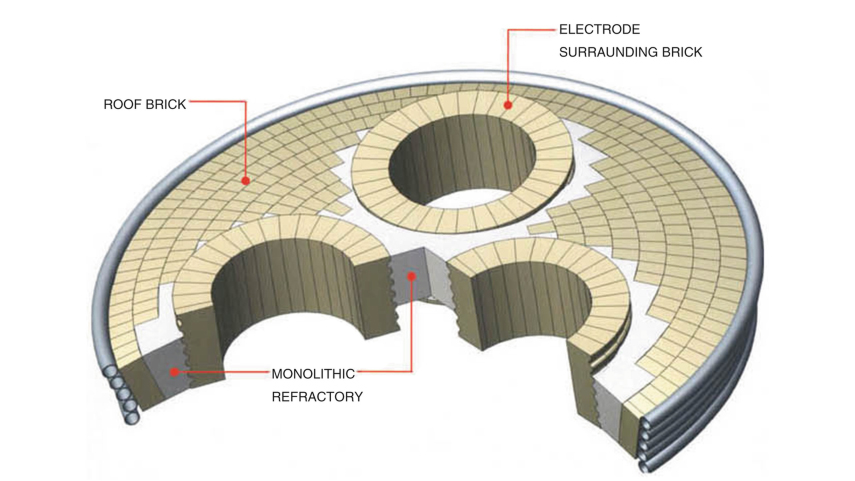An electric arc furnace is a device that uses the heat generated by an arc between the electrode and the charge to refine steel. The development of electric arc furnace technology has led to the use of high power, direct current arc furnaces, bottom-blown oxygen and argon stirring, and bottom tapping. The electric arc furnace consists of a furnace top, furnace wall, furnace bottom, and tapping spout.
Refractory materials for the electric arc furnace:
I. Furnace top:
Typically, high alumina bricks containing between 75% and 85% alumina are used to construct the furnace top of an electric arc furnace.” Compared with silicon bricks, high alumina bricks have the characteristics of high refractoriness, good resistance to thermal shock, and high compressive strength.
Because China possesses ample bauxite resources, electric arc furnace tops mainly utilize high alumina bricks as refractory material, which offer a lifespan approximately 2-3 times longer than that of silicon brick furnace tops. With the development of large ultra-high-power furnaces, the service life of high alumina bricks has been decreasing, leading to the further use of burned or unburned magnesia bricks and magnesia-chrome bricks.
Pre-cast refractory components poured by manufacturers can also be used for hoisting, which have the advantages of convenient construction, good overall performance, strong resistance to arc radiation, and resistance to rapid cooling and heating.
II. Furnace wall:
The general furnace wall is partitioned into the slag line region and the hot spot area located close to the arc.The general wall is mainly constructed of magnesia bricks, dolomite bricks, and magnesia spinel bricks. Burned or unburned magnesia alkaline bricks and magnesia-dolomite and dolomite-lime ramming materials can also be used. The furnace walls of ultra-high-power arc furnaces or those used for special steel smelting are constructed with magnesia chrome bricks and high-quality magnesia bricks.
The slag line area and the hot spot area are the weak points of the furnace wall. Since the life of the furnace wall mainly depends on the degree of damage in the hot spot area, the lining in this area should be given special attention. In the past, magnesia chrome bricks were commonly used, with a lifespan of 100-250 furnace cycles. Now, magnesia carbon bricks are widely used, which show excellent high-temperature resistance and slag resistance. The lifespan is significantly increased to more than 300 furnace cycles.
In order to balance the damage to the furnace wall and extend its lifespan, water-cooled boxes or water-cooled sleeves are also used to line the furnace wall, with a layer of refractory coating sprayed on the inner surface to form a protective layer against slag buildup. This can effectively reduce the unit consumption of refractory materials, but it also increases energy consumption.
III. Furnace bottom:
The furnace bottom and taphole form the melting pool, which is the place where the charge and steel are collected. After the lining of the furnace bottom reacts with the slag and iron oxide to form a transformation layer, it can become loose due to the reduction of some of its components during reduction, which can cause floating due to the invasion of steel. Therefore, the lining or ramming material in this area should have the advantages of uniform overall performance, tight construction, good high-temperature performance, high strength, corrosion resistance, erosion resistance, good thermal shock resistance, and stable volume. Ramming materials are also commonly used in the furnace bottom.


